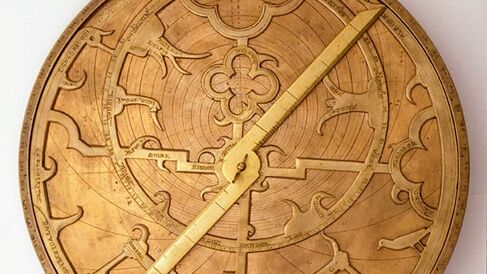A Medieval Astrolabe

The astrolabe was a key astronomical instrument during the Middle Ages. It can be used to tell the time, measure the heights of stars and buildings, and for many other calculations and observations. It works because it is a 2-dimensional representation of the 3-dimensional Universe as understood by the medieval astronomer - with the Earth at the centre of the apparent motion of the Sun.
Like other museums, only a small proportion of our collection is on display at any one time and physical access to museums can be challenging for some. Now you can search and browse through records and images of close to 7,000 objects, as well as records of our Trade Literature.
Reproduction rights
If you wish to obtain rights to reproduce any image, such as in a publication, television programme or other commercial format, please contact the museum (hps-whipple-museum@lists.cam.ac.uk), giving the following details:
- Details of the publication/media in which the image is to be used
- Your requirements for the image (size/colour etc.)
- The extent of rights required (see below for options).
Reproduction fees
The fees for obtaining reproduction rights (excluding VAT) are detailed below. Reproduction fees are in addition to a staff time charge for supplying the images, and the cost of any new photography.
Publications
| One country/One language | World rights/One language | World rights/All languages | |
| Books, partworks, periodicals and electronic works | £80 | £110 | £160 |
| Theses and articles in academic journals | £40 | £60 | £80 |
| Book and audiobook jackets; magazine covers | £160 | £210 | £280 |
| CD, cassette, record, video, DVD or CD-ROM covers (3 year right per format) | £230 | £310 | £410 |
Television and film
(per named programme, per format)
| One country/One language | World rights/One language | World rights/All languages | |
| One-time flash fee up to 12 seconds | £70 | £100 | £160 |
| Repeats | £45 | £50 | £80 |
| 10 years unlimited (all formats, per programme) | £350 | £450 | £650 |
DVD and video
(per format)
| One country/One language | World rights/One language | World rights/all languages | |
| DVD and video (per format) | £100 | £150 | £250 |
| Repeats | £50 | £75 | £125 |
Cost of supplying images
We make a charge of £35 for supplying the first image, plus an additional charge for subsequent images dependent on staff time required. Please contact us for an estimate of costs.
How to order and pay
Please see how to order and pay for more information on placing an order.
All fees must be paid in full before permission to use an image is granted.
Terms and conditions
Permission to reproduce Whipple Museum images is dependent on the full acceptance of the terms and conditions detailed here.
Parts of the instrument
This large brass instrument (Image 1), probably made in the 14th century, is typical of medieval English astrolabes. It has been engraved for the latitude 52 degrees. This is the latitude of London, so it is reasonable to suppose that it was intended for use in the capital.
The rete, a cut-out plate with pointers showing the position of stars, rotates over the projection. Most of the 41 pointers here are labelled with the names of stars, many of them in Arabic, reflecting the Arab influences on medieval European astronomy. One is in the shape of a bird but is not labelled - it is probably marking the beak of the constellation Corvus (the crow).
Read more: parts of the astrolabe
Religious uses
On the back of the astrolabe are concentric circles for calculations relating to the calendar. As well as a zodiac calendar, there is also a calendar in which saints' days and feast days are marked, providing a handy reference for a medieval religious man. We know that monks, friars and clerics were among those who owned astrolabes in the Middle Ages. This doesn't necessarily mean that this astrolabe was made for a religious man - these kinds of scales would also be useful for a politician or a merchant, since the medieval calendar was organised around saints' days and religious festivals.
Catherine Eagleton, 'A 14th-century English astrolabe', Explore Whipple Collections, Whipple Museum of the History of Science, University of Cambridge, 2008.
